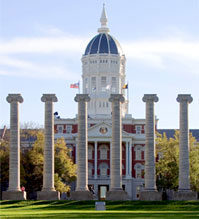MU Engineer Finds Ways to Improve U.S. Rail Passenger Service and Reduce Freight Delays
March 27, 2008
Story Contact: Bryan E. Jones, 573-882-9144, jonesbry@missouri.edu
MU Engineer Finds Ways to Improve U.S. Rail Passenger Service and Reduce Freight Delays
COLUMBIA, Mo. – "I think I can… I think I can…" is a refrain most will recognize as the optimistic, self-encouraging words of "The Little Engine That Could." The children's book protagonist is a determined train engine who succeeds in spite of encountering great difficulty and setback. Currently, the nation's railways are getting attention as a viable option for moving people and goods, as compared to trucking, in the wake of increasing energy costs and highway overcrowding. One University of Missouri engineer is finding ways to improve the efficiency of rail transport—increasing passenger service and reducing freight delays.
"In Europe, they have dedicated passenger networks. In the U.S., freight trains and passenger trains share lines," said Jim Noble, associate professor of industrial engineering in the MU College of Engineering and director of the Center for Engineering Logistics and Distribution. "Much of the congestion is related to the fact that long, heavy freight trains have a huge 'ramp up' and 'ramp down' time and the number and length of existing sidings (places where a train can pull off the main line) is insufficient. Often, the shorter passenger train can get into a siding quickly and easily, but then must wait to let the freight train rumble by, resulting in delays for passengers."
Noble said the core problem is a high, and increasing, train load level—from both a quantity and a weight perspective. He identified four issues that, based on an increasing train load, will ultimately impact the overall level of delay: geographic conditions, maintenance processes, crew scheduling and dispatching priority.
An analysis of Amtrak delay reports in Missouri reveals that the majority of train delay is caused by freight train interference (53.4 percent), temporary speed restrictions (15.1 percent) and passenger train interference (9.7 percent). Noble also found that passenger train delays are directly correlated with the number of passengers utilizing rail service.
Noble developed a prioritized list of rail enhancements that address current passenger and freight rail performance on the Union Pacific line between St. Louis and Kansas City. Noble's findings also may be applicable for rail service improvements in other regions. One issue in the implementation of the findings is capital investment. Both private and public funds will be necessary for the success of the rail enhancements, Noble said.
Noble's study was presented to the Missouri Department of Transportation and the Missouri House Transportation and Economic Development Committee. His findings also will be presented at the 2008 Industrial Engineering Research Conference in Vancouver, British Columbia
-30-



